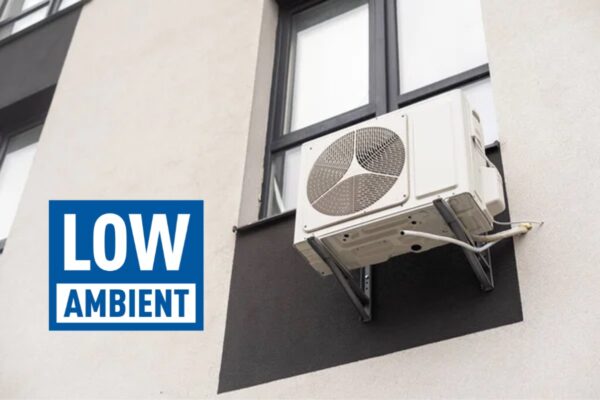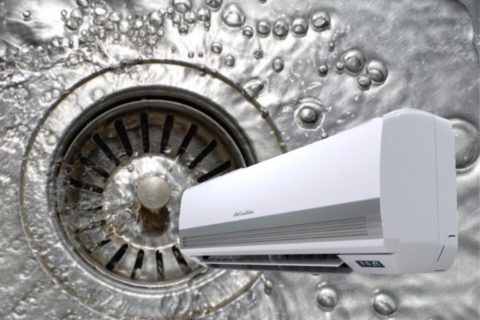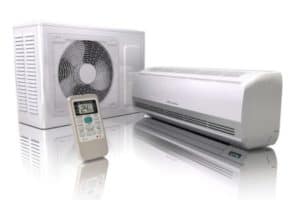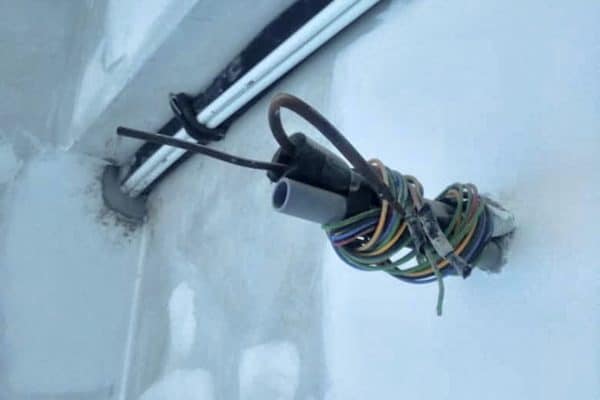Ducted vs Ductless Mini Split (Which is Better?)
More and more people knew about ducted mini splits. It had come to a point where people are starting to compare ducted mini splits to ductless mini splits. So, I thought a comprehensive comparison between the two would be very helpful.
In short, ductless mini splits are cheaper and more efficient than ducted mini splits. However, ducted mini splits offer better interior aesthetics and quietness. Thus, the choice between the two depends on your specific heating and cooling needs, as well as your budget and aesthetic preferences.
Choosing between a ducted mini split and a ductless mini split can be difficult. So, I breakdown different aspects of the two for you to make a more informed decision.
Cost
The cost is the first thing people look at when comparing a mini split. It is perhaps the greatest factor when deciding to make a purchase.
On average, ducted mini splits are 20% more expensive to purchase than ductless mini splits. But, if the ductless mini split is a ceiling cassette type, the purchase cost is similar to a ducted mini split.
Based on my mini split database, the average price of a good ducted mini split (9,000 BTU) is around $2,086.24. On the other hand, the average price of a good wall-mounted ductless mini split (9,000 BTU) is around $1,736.26.
What I mean by “good mini split” is those produced by reputable manufacturers such as Mitsubishi, Daikin, Fujitsu and Gree.
The below chart shows the purchase cost of ducted mini splits and ductless mini splits:
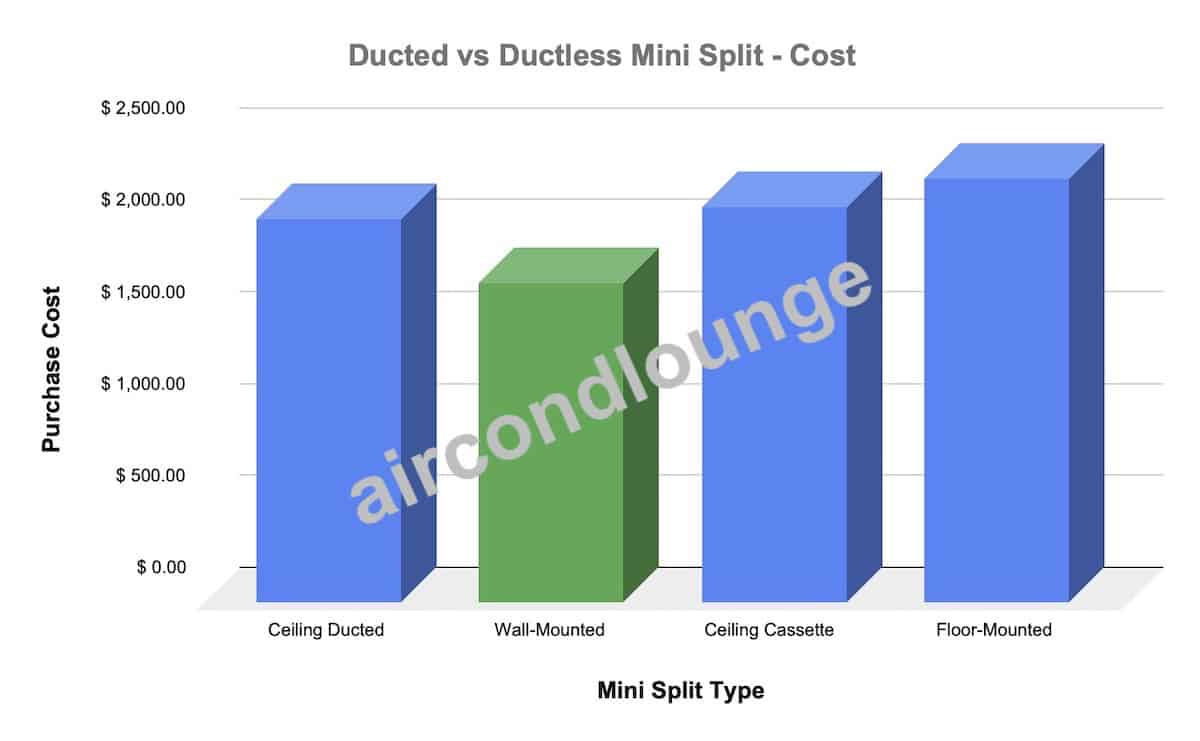
A ducted mini split is technically known as a ceiling ducted unit. Whereas there are a few different types of ductless mini splits but mainly wall-mounted, ceiling cassette and floor-mounted.
As you can see, across various brands and models, ductless mini splits (wall-mounted type) are still the cheapest. Ceiling cassette ductless mini splits are almost the same as ducted mini splits. The most expensive type of mini split is surprisingly the floor-mounted type.
Installation Cost
While it seems like ductless mini splits are only slightly cheaper than ducted mini splits, when you account for the installation cost, the affordability of ducted mini splits drops drastically.
According to LawnStarter, the national average cost to install ductwork is $3,000, with most homeowners spending between $2,000 and $5,000.
If ductwork is needed, the total upfront cost of a ducted mini split (9000 BTU) could range from $4,000 to $7,000 excluding the labor cost. When the labor cost is included, the total upfront cost could shoot up to $9,000.
The installation cost of a ductless mini split only involves the labor cost. Assuming the labor cost of a single unit is $2,000, the total upfront cost of a ductless mini split could be nearly $4,000 only.
But, the good thing about ducted mini splits is when you have a central air, you might be able to connect new ducted mini splits to the existing ductwork.
If that’s the case, it all comes down to the purchase cost. However, with regard to the cost, we need to consider the operating cost as well and hence, the next thing to compare, efficiency.
Vice versa, with ductless mini splits, it is possible to DIY installation yourself to save cost.
Efficiency
Mini splits in general are very efficient. They are more efficient than traditional central air conditioners. However, the efficiency between ducted mini splits and ductless mini splits can be greater than most people anticipated.
On average, ductless mini splits are 24% more efficient in cooling compared to ducted mini splits. In terms of heating performance, ductless mini splits are 5% more efficient than ducted mini splits.
The SEER and HSPF value of a ducted mini split (9000 BTU) on average is 18.50 and 10.60 respectively. In comparison, the SEER and HSPF of a ductless mini split (9000 BTU) on average is 22.98 and 11.08 respectively.
The below chart shows the efficiency of ducted mini splits and ductless mini splits:
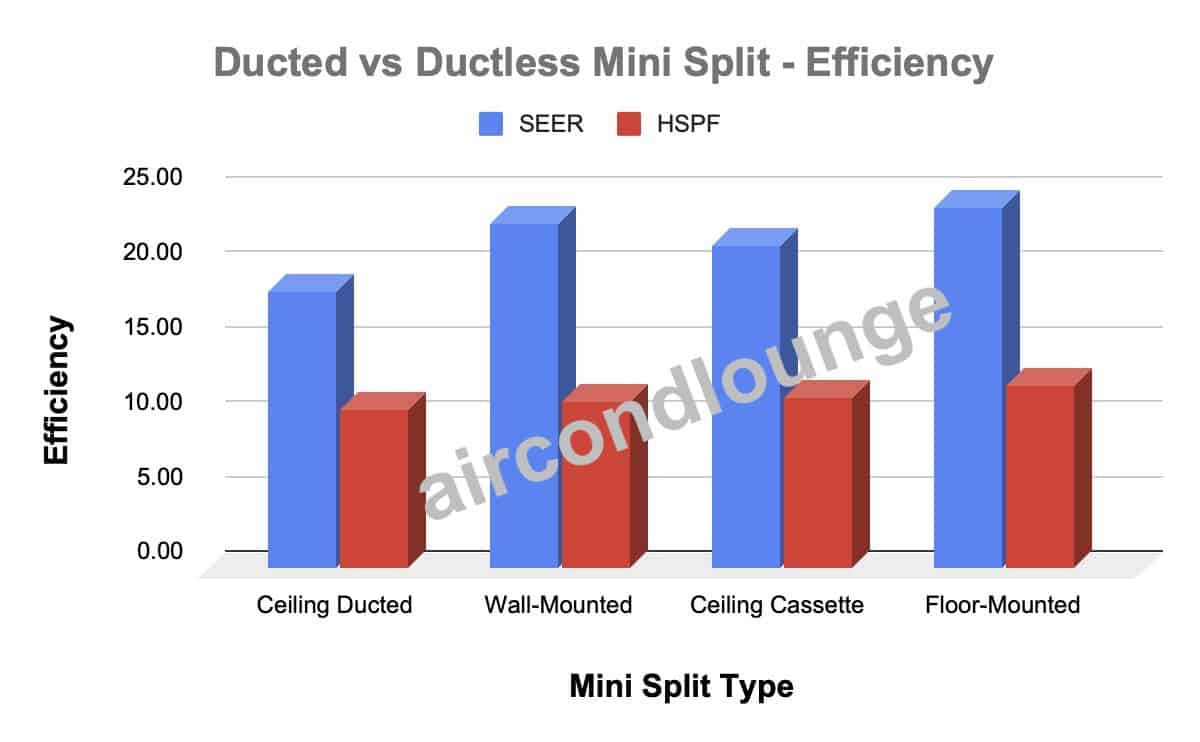
So, whether it is a wall-mounted, ceiling cassette or floor-mounted type, ductless mini splits are still more efficient than ducted mini splits.
It is worth noticing that the floor-mounted type of ductless mini splits are the most efficient type, probably because floor-mounted mini splits are often available in higher-end models only.
By the way, if you want to learn more about mini split especially how to design it for your house, consider my Mini Split (eBook). You’ll learn what is Mini Split, how to choose and more importantly, spark more design ideas to improve the energy efficient of your house. But, if you need a second opinion or want someone to help you design, then you can consider my consultation service.
Consultation Service
Ask me for HVAC advice such as brand selection, best model, benefits, features, placement, duct size, grille size, how to design, design check, verification and other HVAC related queries.
Operating Cost
Since SEER is calculated by dividing BTU by Watt, the wattage of a ducted mini split and a ductless mini split are as follows:
- 9k Ducted Mini Split – SEER 18.50 = 486.48 W
- 9k Ductless Mini Split – SEER 22.98 = 391.64 W
Based on an average electricity cost of $0.23 kWh and assuming that cooling is needed 24/7 for 4 months (one cooling season), the operating cost of a ducted mini split and a ductless mini split can be compared as follows:
9k Ducted Mini Split
486.48 W x 122 hours x 0.23 kWh = $13,650
9k Ductless Mini Split
391.64 W x 122 hours x 0.23 kWh = $10,989
Therefore, a ductless mini split is about $2,661 cheaper to run per cooling season.
From a cost standpoint, ductless mini splits are much better than ducted mini splits. Not only do ductless mini splits are cheaper to purchase and install but they also cheaper to run.
Maintenance
Mini splits need to be serviced regularly to maintain their performance. While their maintenance work is generally simple and straightforward, there are slight differences between ducted mini splits and ductless mini splits.
Ducted mini splits require more maintenance work than ductless mini splits due to the additional ductwork. Besides, it is also more difficult to service and repair a ducted mini split due of its location.
Some ducted mini splits are installed in the attic where the difficulty of the maintenance work is almost the same as a central air. However, many ducted mini splits are installed above the ceiling. A 2×2 ft ceiling manhole is all that it has for service access.
Hence, ducted mini splits are more difficult to service and repair.
On the other hand, ductless mini splits are exposed under the ceiling. They are not installed in a hidden location. So, it is much more easier to carry out the maintenance work for ductless mini splits.
When you factor in the maintenance cost of ducted mini splits, you have one more reason to pick a ductless mini split over a ducted mini split.
Nonetheless, it is the ability of a ducted mini split to be installed in a hidden location that makes it appealing. So, aesthetics might be prioritized over cost advantages.
Lifespan
Both ducted mini splits and ductless mini splits have similar lifespans on the design level. However, consider that ductless mini splits are exposed under the ceiling, their plastic cover tends to turn yellowish over time.
On the other hand, ducted mini splits are located above the ceiling. Furthermore, they don’t have much plastic material, most of their body is made of galvanized steel.
So, ducted mini splits tend to maintain their look much better than ductless mini splits.
Nonetheless, with regard to performance deterioration, both ducted mini splits and ducted mini splits are similar as long as the maintenance work is carried out periodically.
Installation
Ducted mini splits tend to be more difficult and time-consuming to install compared to ductless mini splits due to their location and the fact that they need ductwork.
In comparison, ductless mini splits are much easier to install and hence, the low installation cost. As mentioned earlier, many people installed their ductless mini splits by themselves.
Without existing ductwork, you need to install new ducts, insulation, diffusers and grilles. For new construction, it is easier but for existing homes, it is often not worth the hassle.
However, if a ducted mini split is installed such that the ductwork is minimal, you may find it is not that hard to install a ducted mini split after all.
Brand
Many mini split manufacturers offer ducted mini splits but not all of them do. Reputable brands tend to have more choices and thus, ducted mini splits can be found in their product lineup.
Following are brands that offer ducted mini splits:
- Mitsubishi
- Daikin
- Fujitsu
- LG
- Gree
- Panasonic
- Bosch
- Carrier
- Pioneer
There are other brands not included in the list but do offer ducted mini splits. The listed brands are more popular and known in the United States.
Best Ducted Mini Split Brand and Model
When you finally decided to use a ducted mini split, there are still too many choices. So, I organized them and ranked the best ducted mini split brand and model for you to choose based on your preferences:
| Best Ducted Mini Splits | #1 LG High Static Ducted LH488HHV | #2 Mitsubishi Low Static Ducted SEZ-KD18NA4R1 | #3 Fujitsu Slim Duct 9RLFCD | #4 Daikin Ducted Concealed FDMQ12RVJU |
|---|---|---|---|---|
| Product Image |  | 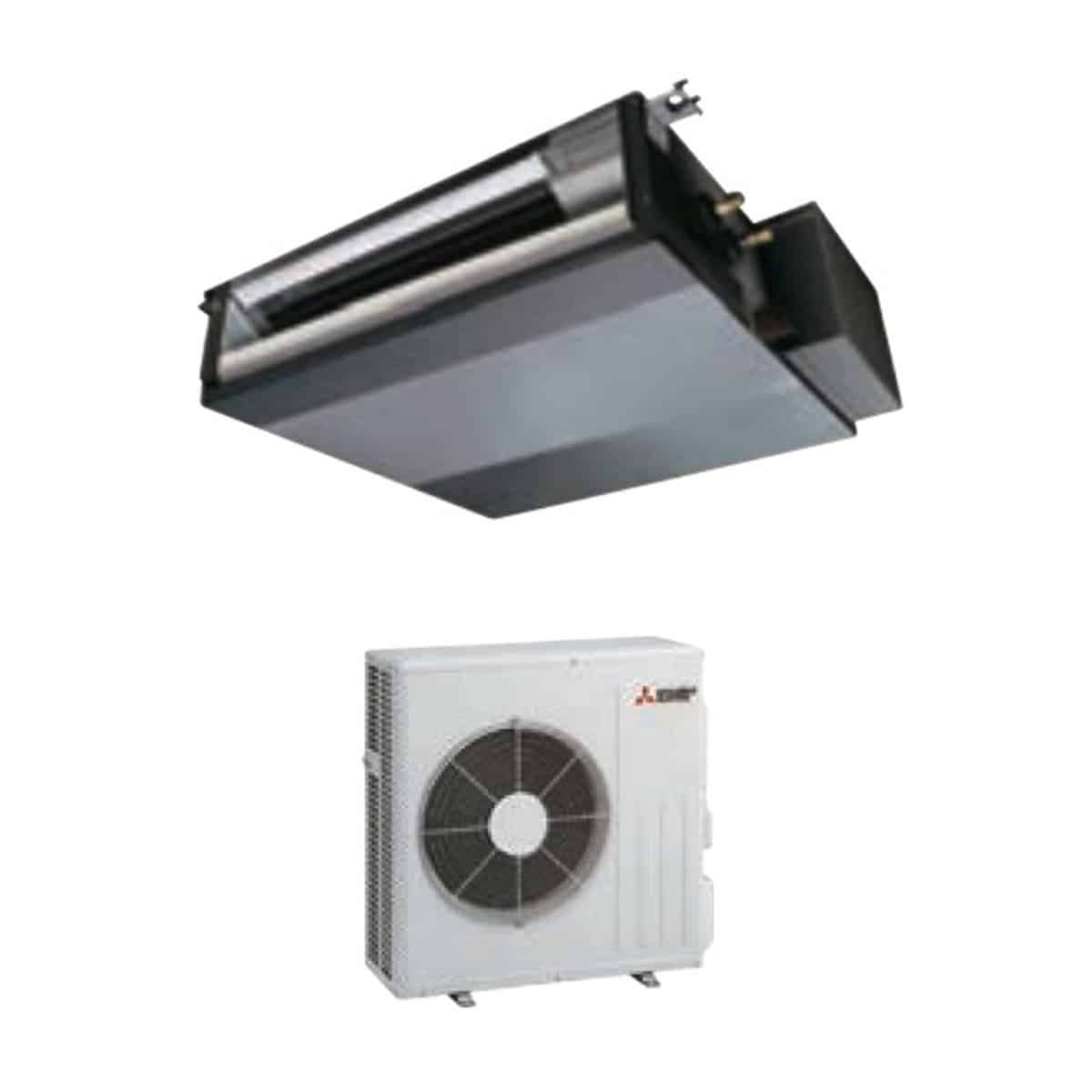 |  | 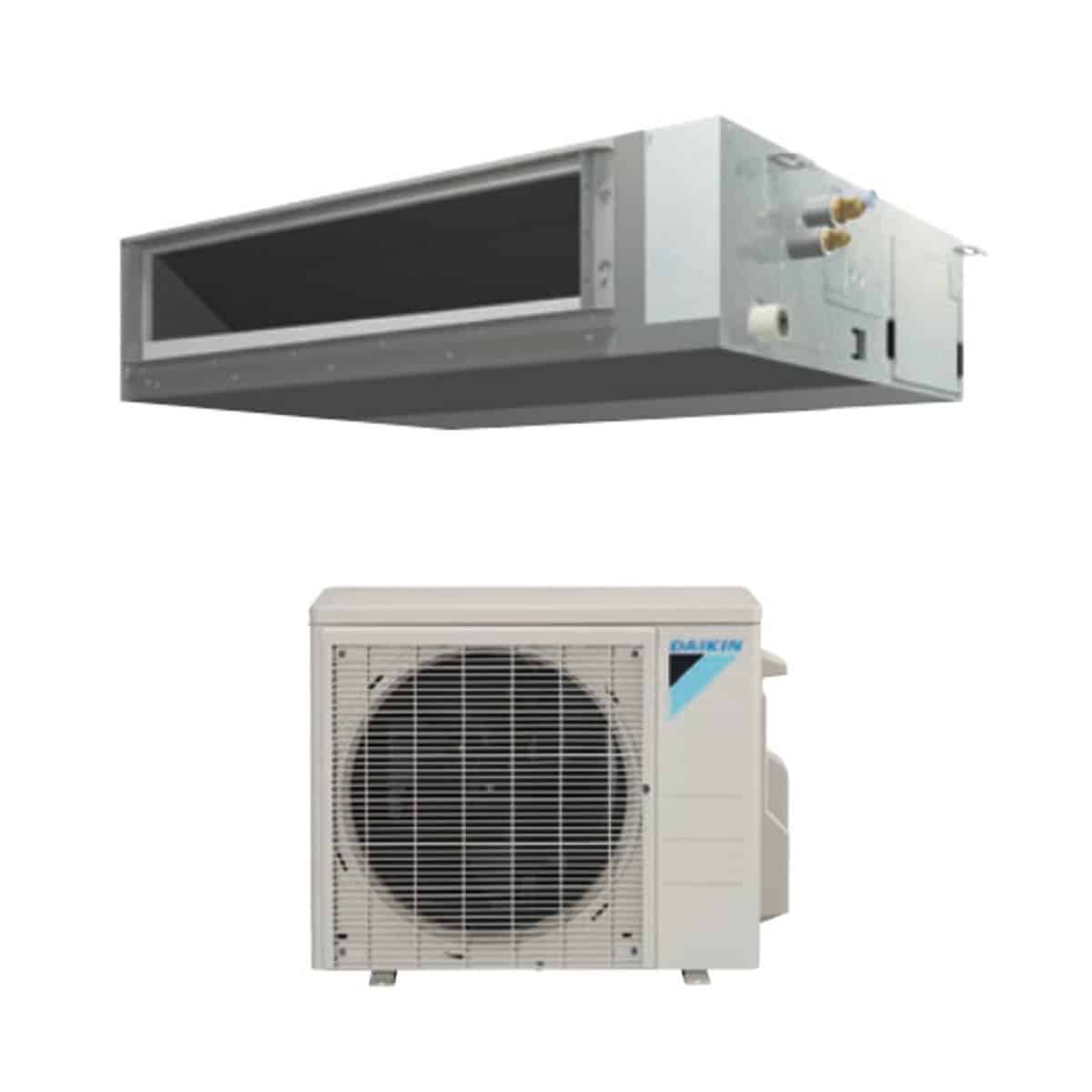 |
| Brand | LG | Mitsubishi | Fujitsu | Daikin |
| Capacity | 48k BTU | 18k BTU | 9k BTU | 12k BTU |
| Efficiency | SEER 18.7; HSPF 11.2 | SEER 19.1; HSPF 10.9 | SEER 21.5; HSPF 12.2 | SEER 19.4; HSPF 10.6 |
| Indoor Unit Dimensions (WxHxD) | 49-7/32 × 14-3/16 × 27-9/16 | 46-7/8 x 7-7/8 x 27-9/16 | 27-9/16 x 7-25/32 x 24-13/32 | 26-9/16 x 21-5/8 × 11-3/16 |
| Best For | Whole House | Garage, Single Floor | 1-2 Rooms | 2-3 Rooms |
When choosing a ducted mini split, you first need to confirm its application. Most people consider a ducted mini split for whole-house heating and cooling. If that’s the case, you want to look for brands that offer large-capacity ducted mini splits like LG, Gree and Fujitsu.
For large applications, you need to make sure that the unit has enough external static pressure. For instance, the LG unit listed above has an external static pressure of 0.59 in.WG. Detailed static pressure calculations must be done by your contractor to ensure the required airflow can be delivered.
For small applications, don’t use long ducts as small-capacity ducted mini splits don’t have great external static pressure to overcome the air resistance in the duct system.
Another important factor to consider is the efficiency. Try to choose one that has great efficiency ratings (SEER & HSPF) compared to its peer to keep your operating cost as low as possible.
When installing a ducted mini split, make sure you reserve space for the maintenance work.
Lastly, consider my Mini Split (eBook) if you want to know how can you use Mini Split in your house. If you still have doubt or not feeling confident enough, feel free to consult me.
Consultation Service
Ask me for HVAC advice such as brand selection, best model, benefits, features, placement, duct size, grille size, how to design, design check, verification and other HVAC related queries.
If you have anything to add (or ask) about this topic, leave a comment down below!



